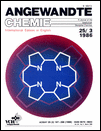Hydroxyacetylene: Generation and Characterization of the Neutral Molecule, Radical Cation and Dication in the Gas Phase†‡
This work was supported by the Fonds der Chemischen Industrie and the Deutsche Forschungsgemeinschaft. J. K. T. thanks the Deutscher Akademischer Austauschdienst (DAAD) for a Science Exchange Award.
Dedicated to Professor David Ginsburg on the occasion of his 65th birthday
Abstract
The simplest ynol, the title compound 2, like the singly and doubly positively charged species 3 and 4, respectively, could be generated in the mass spectrometer. Cleavage of CO from 1 furnished the radical cation 3, which on neutralization with Xe affords the neutral ynol 2. The radical cation 3 can be converted into the dication 4 by charge stripping.





